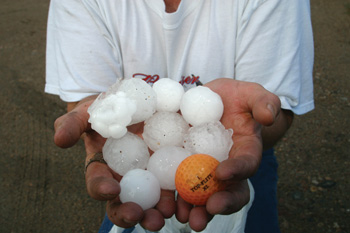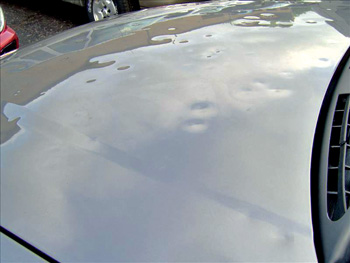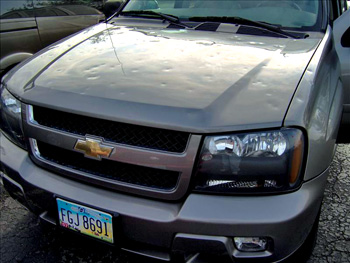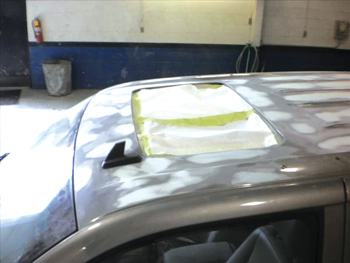 Do we have an insurance company “partner,” or will they abandon ship at the first sign of trouble? In the corporate environment we work in today, you can bet that some will run at the first sign of trouble, while others will stay and help. We found that out the hard way after the worst hailstorm we had ever seen blew through.
Do we have an insurance company “partner,” or will they abandon ship at the first sign of trouble? In the corporate environment we work in today, you can bet that some will run at the first sign of trouble, while others will stay and help. We found that out the hard way after the worst hailstorm we had ever seen blew through.
Catastrophe Strikes
I’ve been in the automotive business for more than 35 years and I’ve never been through anything like the hailstorm that hit my area (Beavercreek/Xenia/Dayton, Ohio) on May 25, 2011. I’ve experienced hailstorms, ice storms, floods, blizzards, locusts, flies and a major tornado that hit my area on Sept. 20, 2000. But the 2011 hail storm caused more repairable vehicle damage in a concentrated area at one time than anything before.
It was a catastrophic storm by insurance company standards, and not our normal way of doing business. It took us a couple months to get a handle on the volume and the total amount of damage.
The first two days, we had more than 150 vehicles dropped onto our lot for repairs. Plus, more than 450 of our dealership’s new and used vehicles suffered damage and needed to be repaired as soon as possible.
We set up some insurance drive-thrus and had adjusters all over the place. We had a half dozen paintless dent repair (PDR) companies show up the first day after the storm, some good and some not so good. It took awhile to get them set up and sort out the professionals from the hacks.
The hail damage ranged from marble-size to baseball-size, and windshield and rear glass damage was common. We hired more techs (all we could find) and estimators to help, but we were already months behind and playing catch-up. For the next six months, we averaged 100 to 120 vehicles on the lot, most with severe damage. We normally handle 40 to 60 vehicles and maintain a nine-plus CSI score (10 being a perfect score).

By the end of 2011, our total customer pay volume was up more than $1 million, and all of it came in the last six months. This overload continued as we scheduled hail repair through March 2012.
Our CSI score with one insurer fell from 9.57 in January 2011 to 8.57 in December 2011. The workload for that insurer alone went up 63 percent in the last half of 2011 compared to the first half of 2011. We had been on this insurer’s DRP for more than 12 years and had never been suspended or reprimanded in any way.
I asked this insurer if I could be re-evaluated at the end of the first quarter of 2012, but I was only given till the end of January 2012 – three days! This insurer had made up about 15 percent of our workload and had been a valued partner in our business. We also had a good working relationship with their local field manager and adjusters. On or off the DRP program, we will continue to honor our agreement and give the best customer service possible.
Not Fast Enough
The No. 1 complaint we got was that we couldn’t get the repairs done fast enough. It was a scheduling nightmare. Some cars could be done with PDR, while others needed conventional repair. Most, however, needed both. And most needed glass work as well, so we also needed to schedule glass companies to a) replace or pull glass for roof replacements or repair work, and b) reinstall after refinishing. The problem is that the glass companies were dealing with the same overload and scheduling problems the body shops were.

Most vehicles came in with poorly written estimates and needed major repair changes. Almost all needed a supplement of some kind, which would cause an insurance hold in most cases. For all the PDR work, we needed the PDR techs to estimate the work needed and supplement it to the insurers for approval.
After the PDR techs did what they could do, we needed to complete a total estimate for the repair. Sometimes the PDR techs cracked the paint or couldn’t get the dent to come all the way out; thus, the estimate would be changed to a conventional repair or paint work – which of course added to the scheduling nightmare.
For example, we would schedule a PDR repair that would take three or four days but not include the roof because they couldn’t repair it. Thus, it would become a three- to four-week repair. We had to add four large trailers to store parts as they came in. We got some hoods and fenders in two or three days, but then had to wait months for roofs, roof rails and sunroofs.
Patience Is a Virtue
After our customers had to wait for weeks or months to get their vehicles in the shop for repairs, it was hard to ask them to be patient with us. They didn’t understand how the insurance estimates could be so far off. In all fairness to the field estimators, they hadn’t ever experienced hail damage of this magnitude and, in some cases, were totally at the mercy of the PDR companies.
Some customers also worried about rental coverage running out, knowing they only had 30 days. Some big jobs took more than 30 days to repair. We had several repairs around $20,000, and some parts began to run short in supply after the storm. Over the last six months of 2011, we paid out more than $60,000 in car rental expenses to help our customers deal with this catastrophe.
Customer satisfaction is always our No. 1 goal. We have 13 other DRP partners that are trying to help us get our CSI back to where it was before the storm. It’s just one that isn’t.
Apples to Apples
I was told that the problem we had with the insurer that dropped us was at the corporate level. The scoring system with insurance companies on CSI doesn’t consider volume. If a shop does 100 repairs a month and has four bad customer satisfaction surveys, that means 96 percent of your customers were satisfied. If the shop does 10 repairs and has three bad surveys, that means 70 percent of your customers were satisfied. That clearly illustrates why volume should be a consideration when figuring out CSI.
 Local problem or corporate problem, when it comes to comparing collision repair centers, insurers should compare apples to apples and consider the total picture. The hail storm only hit an area around Dayton, so to compare us to shops in Southern Ohio that didn’t have to deal with any hail damage is
Local problem or corporate problem, when it comes to comparing collision repair centers, insurers should compare apples to apples and consider the total picture. The hail storm only hit an area around Dayton, so to compare us to shops in Southern Ohio that didn’t have to deal with any hail damage is
ludicrous and leaves you with a distorted picture.
Abandoning ship after a storm may help the insurance company’s CSI scores for a short time and briefly relieve the corporate pressure, but in the long run, it could create inconvenience for our mutual customer.
My main point is that DRPs belong to the insurance companies. Whether it’s your fault, their fault or nobody’s fault at all, it’s their program and they can drop a shop with only a phone call. I’m thankful we had 13 other DRPs to lean on.
A Good Thing
Please don’t think I’m whining about the overload of work we had; we were glad to have it. It resulted in record-breaking sales, which was good for everyone. The hail fell like manna from heaven, but just like the manna from heaven in the Bible, you couldn’t store it because it wouldn’t keep.
The timeframe we had to take advantage of this blessing was limited, and if we hadn’t handled it in a timely manner, it would have become a mess. We learned from our experience and now know what we would do differently if it happens again.
John Maxwell once said, “The pessimist complains about the wind. The optimist expects it to change. The leader adjusts the sails.” So hold on! We’re adjusting our sails to the wind and starting on a new course, totally committed to improving our CSI scores.
P.S. The first half of 2012 ended with customer sales up 30 percent over last year and 98 percent of our repairs were delivered on time. We also showed improvement with all of our CSI scores and had a 9.8 average – and one CSI score was a perfect 10! Thanks to the 13 DRP partners that are helping us right the ship – and good luck to the one who’s jumping out.
Jim W. Patrick is the collision repair manager for Lang’s Chevrolet in Beavercreek, Ohio. He can be reached at [email protected].













